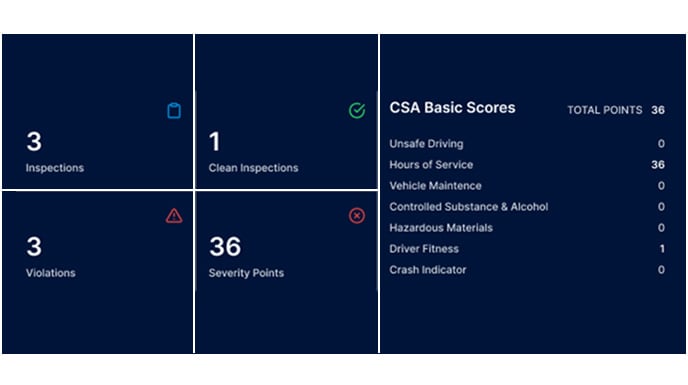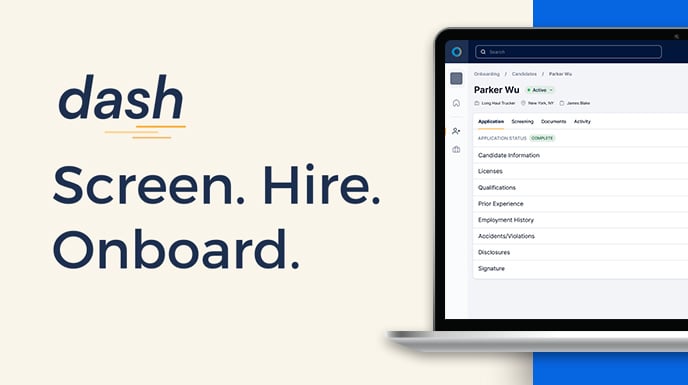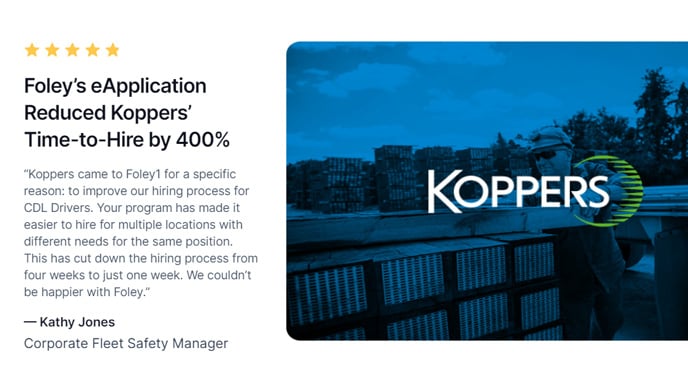Understanding DOT Roadside Inspections (and How to Pass Them)

DOT roadside inspections will be on the rise in the next few months.
Over 400,000 roadside inspections have been conducted so far in 2025, with nearly 82,000 of them resulting in at least one out-of-service (OOS) violation. The number of these inspections is expected to continue to climb, especially as International Roadcheck 2025 kicks off in less than two months.
When a driver receives an OOS violation, they cannot resume driving until the issue has been resolved. This can cause serious delays in any company's operations, especially those with a limited number of drivers.
Out-of-service orders are also recorded on a company's Compliance, Safety, and Accountability (CSA) score for 24 months. The more recorded safety issues your company has, the higher your score will be — which only increases your chances of facing additional federal interventions, like safety and compliance audits.
The key to passing roadside inspections is understanding the following:
- How drivers are selected for the inspections
- What the various inspection levels involve
- The top driver roadside inspection violations for 2025 so far
- The top vehicle roadside inspection violations for 2025 so far
- How to avoid both driver and vehicle violations
We dive into each of these factors below.
How are commercial drivers chosen for roadside inspections?
Certain drivers and commercial vehicles are usually selected for roadside inspections because an officer has spotted something off about their driving behavior or the state of their commercial vehicle. The driver could be speeding, or maybe one of the vehicle's tires is flat.
However, unlike non-commercial vehicles, officers don’t need a specific reason to pull over a CMV driver. They will often pull over a driver for the sole purpose of conducting an inspection.
What are the different roadside inspection levels?
There are seven roadside inspection levels, each less complex as the level number increases.
- Level 1 – This is not only the most common type of roadside inspection but also the most detailed and comprehensive. The inspector will check the driver’s documentation (including CDL, medical certificate, and others) as well as the entirety of the vehicle's interior and exterior.
- Level 2 – Nearly identical to level one inspections; however, the inspector will do a walk-around inspection of the vehicle rather than conducting an extensive examination.
- Level 3 – A driver-only inspection in which the officer will thoroughly examine a driver’s records, including daily logs and vehicle inspection reports.
- Level 4 – One-time inspection of a particular vehicle or driver item, likely in the case of an ongoing company investigation.
- Level 5 – A level one check of the commercial vehicle without the driver present.
- Level 6 – A specific inspection of vehicles hauling transuranic waste and Highway Route Controlled Quantities (HRCQ) of radioactive material.
- Level 7 – An inspection that applies to school buses, limousines, taxis, hotel courtesy shuttles, and other intrastate passenger vehicles specifically.
To learn more about each type of CMV roadside inspection, click here.
What are the top driver roadside inspection violations?
The top five driver violations and the number of occurrences for 2025 so far are as follows:
- Speeding 8-10 MPH over the speed limit - 8,200
- ELD form and manner violation - 7,863
- False report of driver record of duty status - 7,340
- Operating a property-carrying vehicle without possessing a valid medical certificate - 7,211
- Lane restriction violation - 6,650
The majority of these are based on driver behavior, which can be tracked with an MVR monitoring program. Employers can enroll any number of drivers, receive notifications if any changes are reported to their license records, and address any violations that may come up.
In terms of violation numbers two and three, your drivers must adhere to all federal hours-of-service regulations and keep their record of duty status (RODS) updated throughout their routes. One of the focus areas for the 2025 CVSA Roadcheck blitz is records of duty. Inspectors will be looking for false HOS records and ELD violations during this year's roadside inspections.
Plus, performing basic DOT background checks on drivers during the pre-employment process can ensure they have the required licenses and endorsements to operate your company's commercial vehicles legally.
What are the top vehicle roadside inspection violations?
These are the top five vehicle violations and the number of times they've been recorded in 2025 so far:
- Operating a CMV without documentation of a periodic inspection - 20,008
- Inoperable required lamp - 16,942
- Clamp or roto type brake out of adjustment - 15,387
- Tires - All others, leaking or inflation less than 50% of the maximum inflation pressure - 13,779
- Lighting - Identification lamp(s) inoperative - 9,368
Regularly inspecting and maintaining your CMVs not only reduces your risk of the above violations, but also helps ensure your drivers are safe behind the wheel.
Tires are the vehicle focus area for this year's Roadcheck inspections. Remind drivers to perform pre- and post-trip inspections, carefully check all tires for signs of wear, and report any issues to your maintenance team.
How to Pass Roadside Inspections in 2025
Although your driver may not be able to avoid being pulled over, it is possible to prevent OOS orders that may result from a random roadside inspection.
Implementing an effective preventative maintenance program can help your team recognize potential issues with your commercial vehicles before your drivers take them on the road. Managing your vehicle maintenance recordkeeping is also key to staying organized, keeping up with regular maintenance, and ensuring your drivers have the right documentation with them in the event of a roadside inspection.
In terms of avoiding driver violations, creating and maintaining DOT-compliant driver files is the best way to stay on top of your drivers' qualification documents, like their CDLs, medical certificates, and more. Inspectors will typically check these items for their validity and expiration, especially during level-one inspections.
Talk to a Foley compliance expert today about how easy it can be to manage your DOT recordkeeping requirements so your drivers can have better chances at passing roadside inspections in 2025.
Related Articles
CVSA Roadcheck 2024 is a Month Away. Are You Ready?
May 2021 Roadcheck Dates Announced
The CVSA Releases Roadcheck 2025 Inspection Focus Areas
.png)




